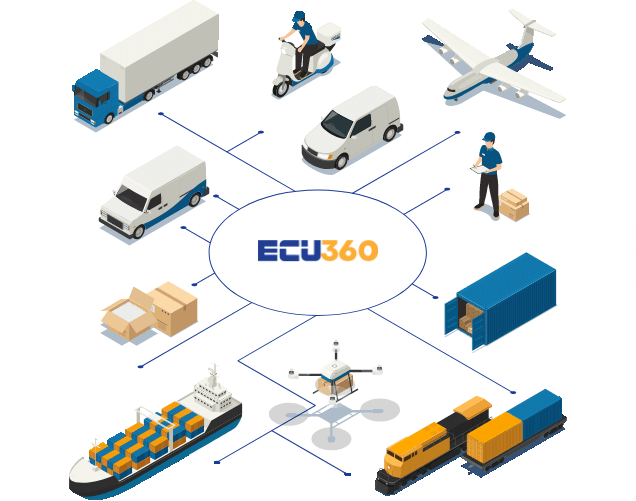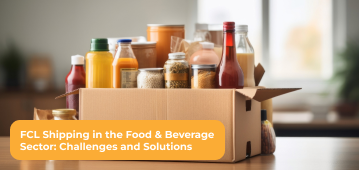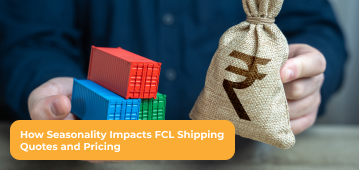Important Points to Remember for FCL Shipping
In the fast-moving world of global logistics, Full Container Load (FCL) shipping stands out as one of the most efficient ways to transport large volumes of goods across international borders. For businesses dealing with bulk freight, understanding FCL shipping is crucial for cost savings, smoother customs clearance, and overall logistics efficiency.
In this guide, we’ll walk you through the key points to remember when planning FCL cargo, from FCL documentation and container loading tips to cargo safety measures and port procedures. Whether you’re a first-timer or a seasoned exporter, these insights will help streamline your FCL freight process.
What Is FCL Shipping?
FCL (Full Container Load) shipping refers to the transportation of goods that fill an entire shipping container. Unlike Less than Container Load (LCL) where multiple shippers share a container, FCL provides a dedicated container solely for your cargo. This approach ensures:
- Better security
- Less risk of contamination or damage
- Simplified customs clearance
- Faster transit time
FCL is ideal for businesses shipping large or heavy goods, or those who prioritize shipment integrity and direct delivery.
- Understand the Basics of Container Types and Sizes
Before booking your shipment, it’s important to choose the right container based on your cargo type and volume. The most common shipping container sizes are:- 20-foot container: Holds around 25–28 CBM (cubic meters)
- 40-foot container: Holds around 55–58 CBM
- 40-foot High Cube: Offers about 76 CBM of volume
Ensure your cargo doesn’t exceed the container weight limits and volume capacity. Overloading can lead to rejection at ports, penalties, or unsafe transit.
Tip: For light but bulky goods, consider high cube containers. For dense, heavy cargo, ensure weight is evenly distributed.
- Plan for Proper Cargo Packaging
Efficient packaging for FCL is critical to protect your goods during long sea voyages. Invest in durable, stackable, and water-resistant packaging materials. Here are best practices:- Use moisture barriers and desiccants to prevent mold and moisture damage
- Secure pallets tightly to avoid movement
- Reinforce corners of boxes for added protection
- Label all packages clearly for port and warehouse staff
Cargo should be easy to load and unload with forklifts or cranes, reducing risk of damage and handling delays.
- Follow the FCL Shipping Checklist
A comprehensive FCL shipping checklist ensures nothing gets missed. Key items include:- Final commercial invoice
- Packing list
- Bill of lading (or sea waybill)
- Certificate of origin (if required)
- Import/export permits
- Cargo insurance
- HS Codes for each item
Additionally, ensure your shipping labels match your documentation exactly. Discrepancies can cause customs clearance process delays or fines.
- Understand Customs Regulations
Every country has different import/export rules, documentation requirements, and restricted goods lists. It’s essential to:- Stay updated with customs procedures at both origin and destination
- Prepare all necessary certificates and licenses
- Declare correct cargo value to avoid penalties
- Work with a freight forwarder to manage the customs clearance process
If you’re shipping to multiple countries, partner with experienced freight forwarding companies who specialize in international trade compliance.
- Maximize Efficiency with Accurate Container Loading
Efficient container loading not only saves space but also prevents cargo shifting or damage during transit. Here are some container loading tips:- Load heavier goods at the bottom and lighter ones on top
- Maintain an even weight distribution across the floor of the container
- Use straps, nets, and blocking to secure items
- Avoid empty spaces to prevent movement
- Do not exceed the container load capacity
An optimized container load reduces the risk of product damage and ensures safety throughout the journey.
- Take Note of Port Procedures and Schedules
Understanding port procedures at both ends of your shipment can prevent unnecessary delays or demurrage charges. Key points include:- Booking cut-off dates for container delivery at the port
- Required documentation at port terminals
- Handling of dangerous or oversized cargo (special permits may be required)
- Port working hours and holidays that may affect operations
Tracking and understanding port-to-port delivery timelines also help you better plan inventory and distribution.
- Choose the Right Freight Partner
Partnering with the right freight forwarding company can make or break your FCL shipping experience. Look for companies that:- Offer transparent pricing for full container shipping rates
- Provide customs and compliance support
- Have a strong network in both origin and destination countries
- Handle tracking, scheduling, and container logistics
- Offer consolidated FCL and LCL options depending on your growth
A reliable logistics partner like ECU Worldwide ensures that your goods are shipped safely, affordably, and on time.
- Maintain Accurate Documentation Throughout
Missing or incorrect documentation is one of the leading causes of FCL cargo handling issues. From the initial booking to delivery at the destination, ensure:- All details in documents match actual cargo dimensions, contents, and values
- HS codes, consignee/shipper details, and payment terms are clearly defined
- You retain digital and physical copies of all documents
Automation tools and cloud-based platforms can simplify this task and reduce human error.
- Prepare for Delays and Track Your Shipment
Delays due to weather, port congestion, or customs inspection are common in sea freight container movement. Always:- Build time buffers in your delivery schedule
- Choose carriers with strong service records
- Use platforms with real-time tracking features
- Communicate proactively with customers and stakeholders
FCL logistics solutions that provide complete visibility allow you to respond quickly to unexpected changes.
- Review Insurance and Safety Measures
While FCL is generally safer than LCL, unforeseen events like accidents or piracy can still occur. Make sure your cargo safety measures include:- Marine cargo insurance
- Tamper-proof seals
- Load tracking devices (if valuable)
- Pre-shipment inspection (for high-value cargo)
Having a comprehensive safety strategy protects your business from financial losses and reputation damage.
- Prepare for International Freight Complexities
International freight tips for FCL shipping include:- Understanding Incoterms (like FOB, CIF, etc.)
- Verifying documentation required by destination countries
- Factoring in tariffs and duties for budgeting
- Knowing how political events, strikes, or natural disasters may affect port access
Being proactive rather than reactive helps ensure a smoother shipping experience.
- When FCL Is Better Than LCL
While LCL is great for small shipments, FCL vs LCL decisions often come down to:- Shipment size: If your cargo occupies more than 12–15 CBM, FCL is typically more cost-effective.
- Handling concerns: With FCL, your goods are loaded once and unloaded once—less risk of damage.
- Transit time: FCL is generally faster as there’s no need to wait for cargo consolidation or deconsolidation.
Choosing FCL helps businesses with growing shipment volumes manage costs and timelines more effectively.
Final Thoughts
FCL shipping is a strategic logistics solution for businesses needing full-container freight capacity. By paying attention to important points like proper documentation, efficient container loading, cargo safety measures, and port procedures, companies can greatly improve efficiency, minimize risk, and lower overall costs.
Whether you’re new to global trade or managing high-volume exports, ECU360 provides end-to-end FCL freight services, backed by expertise in international container shipping, real-time tracking, and customized logistics solutions. With ECU360, simplify your FCL cargo handling from booking to delivery—seamlessly and securely.
Need help with Full Container Load shipping?
Contact ECU360 today to explore optimized freight solutions tailored to your business needs.
Like





Comments